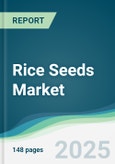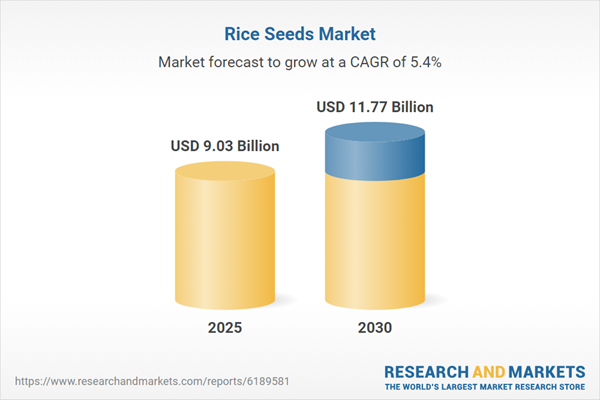The global rice seed market is poised for steady growth, driven by increasing global rice production and advancements in agricultural practices. Rice seeds, derived from Oryza sativa (Asian rice) or Oryza glaberrima (African rice), are critical for meeting the rising demand for rice, a staple food for billions. Key growth factors include growing awareness of the impact of high-quality commercial seeds on yield, technological advancements in rice breeding, and the need to maximize production on shrinking arable land amid rapid urbanization and population growth. These drivers are pushing innovation to achieve higher yields with fewer resources.
Market Drivers
The increasing global population and subsequent rise in rice consumption are primary drivers, as rice remains a dietary cornerstone in many regions. Growing awareness among farmers about the benefits of commercial rice seeds, which offer improved yield and resilience compared to traditional varieties, is boosting market demand. Technological advancements in rice breeding, such as hybrid seed development and genetic improvements, are enhancing crop productivity and resistance to environmental stresses, further supporting market growth. The challenge of limited arable land due to urbanization has spurred research into high-yielding seed varieties, driving adoption of advanced rice seeds.Market Restraints
Challenges to market growth include the high cost of hybrid and genetically improved seeds, which can be prohibitive for small-scale farmers in developing regions. Additionally, limited access to modern agricultural infrastructure and technical knowledge in some areas may hinder the adoption of advanced rice seeds, slowing market expansion.Market Segmentation
The rice seed market is segmented by type, product, grain size, treatment, and geography. By type, the market includes open-pollinated and hybrid rice varieties, with hybrids gaining traction for their higher yields. By product, segments include arborio, basmati, brown rice, jasmine, white rice, and others, catering to diverse consumer preferences. Grain size segmentation covers long-grain, medium-grain, and small-grain rice, each suited to specific culinary uses. Treatment segments include treated and untreated rice seeds, with treated seeds offering enhanced disease resistance. Geographically, the market spans North America, South America, Europe, the Middle East and Africa, and Asia-Pacific, with detailed analysis of 15 key countries. Asia-Pacific likely dominates due to its extensive rice cultivation, while other regions show growth potential driven by increasing food security concerns.Competitive Landscape
Major players in the rice seed market are focusing on innovation, strategic partnerships, and investments to strengthen their positions. The report highlights recent deals and investments over the past year, alongside company profiles detailing business overviews, financial performance, key products, and recent developments. While specific companies are not named, leading players are likely those with expertise in seed technology and global distribution networks.Research Methodology
The market analysis integrates comprehensive segmentation, lifecycle analysis, and regional forecasts. It examines demand, supply, and sales trends, supported by insights into market dynamics, technology penetration, and regulatory frameworks. Data from industry reports and proprietary datasets ensure accurate forecasting and market insights.In conclusion, the rice seed market is set for steady growth, driven by rising rice demand, advancements in breeding technologies, and the need for efficient land use. Asia-Pacific remains a key region, with hybrid seeds gaining prominence. High seed costs and infrastructure limitations pose challenges, but leading companies are leveraging innovation to address these issues and capitalize on emerging opportunities in global rice production.
Key Benefits of this Report:
- Insightful Analysis: Gain detailed market insights covering major as well as emerging geographical regions, focusing on customer segments, government policies and socio-economic factors, consumer preferences, industry verticals, and other sub-segments.
- Competitive Landscape: Understand the strategic maneuvers employed by key players globally to understand possible market penetration with the correct strategy.
- Market Drivers & Future Trends: Explore the dynamic factors and pivotal market trends and how they will shape future market developments.
- Actionable Recommendations: Utilize the insights to exercise strategic decisions to uncover new business streams and revenues in a dynamic environment.
- Caters to a Wide Audience: Beneficial and cost-effective for startups, research institutions, consultants, SMEs, and large enterprises.
What do businesses use our reports for?
Industry and Market Insights, Opportunity Assessment, Product Demand Forecasting, Market Entry Strategy, Geographical Expansion, Capital Investment Decisions, Regulatory Framework & Implications, New Product Development, and Competitive Intelligence.Report Coverage:
- Historical data from 2022 to 2024 & forecast data from 2025 to 2030
- Growth Opportunities, Challenges, Supply Chain Outlook, Regulatory Framework, and Trend Analysis
- Competitive Positioning, Strategies, and Market Share Analysis
- Revenue Growth and Forecast Assessment of segments and regions including countries
- Company Profiling (Strategies, Products, Financial Information, and Key Developments among others)
Segmentation
- By Type
- Open Pollinated Rice Variety
- Hybrid Rice Variety
- By Product
- Arborio
- Basmati
- Brown Rice
- Jasmine
- White Rice
- Others
- By Grain Size
- Long Grain Rice
- Medium Grain Rice
- Short Grain Rice
- By Treatment
- Treated Rice
- Untreated Rice
- By Geography
- North America
- USA
- Canada
- Mexico
- South America
- Brazil
- Argentina
- Others
- Europe
- Germany
- France
- United Kingdom
- Spain
- Others
- Middle East and Africa
- Saudi Arabia
- UAE
- Others
- Asia-Pacific
- China
- India
- Japan
- South Korea
- Indonesia
- Thailand
- Others
- North America
Table of Contents
Companies Mentioned
- Bayer CropScience Limited
- DuPont de Nemours, Inc.
- Advanta Limited
- NUZIVEEDU SEEDS
- Kaveri Seeds
- Rallis India Limited
- Mahyco
- SL Agritech Corporation
- Rasi Seeds (P) Ltd.
- Syngenta
Table Information
| Report Attribute | Details |
|---|---|
| No. of Pages | 148 |
| Published | November 2025 |
| Forecast Period | 2025 - 2030 |
| Estimated Market Value ( USD | $ 9.03 Billion |
| Forecasted Market Value ( USD | $ 11.77 Billion |
| Compound Annual Growth Rate | 5.4% |
| Regions Covered | Global |
| No. of Companies Mentioned | 10 |









